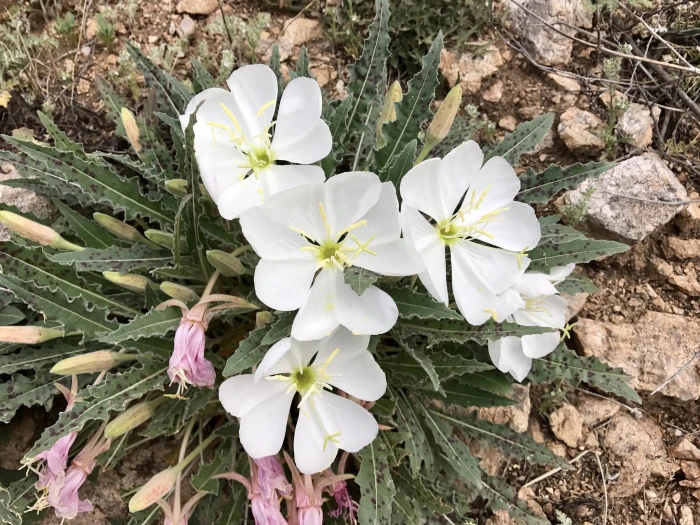Tufted Evening Primrose
(Oenothera cespitosa)
Tufted Evening Primrose (Oenothera cespitosa)
/
/

CK Kelly
CC BY 4.0
Image By:
CK Kelly
Recorded By:
Copyright:
CC BY 4.0
Copyright Notice:
Photo by: CK Kelly | License Type: CC BY 4.0 | License URL: http://creativecommons.org/licenses/by/4.0/ | Rights Holder: CK Kelly | Publisher: iNaturalist | Date Created: 2017-04-01T15:53:12Z |










Estimated Native Range
Climate Requirements for Dakar, Senegal
| This Plant | Your Site | Plant Suitability for Your Location | ||
|---|---|---|---|---|
| • Precipitation | 5" - 35" | 16" | Your precipitation may be too high for this plant. | Too high |
| • High Temp. | 61°F - 107°F | 89°F | Your summer temperatures are normal for this plant. | Excellent |
| • Low Temp. | -22°F - 45°F | 61°F | OK, but your winter temperatures are warmer than normal for this plant | OK |
This plant may not grow well at your location - your precipitation is too high.
Summary
Oenothera cespitosa, commonly known as Tufted Evening Primrose or Fragrant Evening Primrose, is a perennial herb that is native to a variety of habitats including grasslands, open woodlands, and rocky outcrops in western and central North America. This species often thrives in well-drained soils of prairies, plains, and foothills, preferring open areas where it can receive ample sunlight. It typically forms a low-growing rosette of lobed or toothed leaves and is known for its striking white, four-petaled flowers that bloom at dusk, emitting a pleasant fragrance. These flowers are night-blooming and are pollinated by nocturnal hawkmoths, with the blossoms wilting by the following morning and gradually turning pink as they age. The plant reaches a modest height of 4-12 inches (10-30 cm) and spreads to about the same width.
Tufted Evening Primrose is valued for its evening blooms and fragrance, making it a unique addition to night gardens and moon gardens where its nocturnal flowering can be appreciated. It is also drought-tolerant, making it an excellent choice for xeriscaping and rock gardens. In cultivation, it requires minimal maintenance, thriving in full sun with low to moderate water needs and well-draining sandy or gravelly soils. While it is not commonly afflicted by diseases, overwatering can lead to root rot. Its ability to attract pollinators like the white-lined sphinx moth adds to its ecological value in garden settings.CC BY-SA 4.0
Tufted Evening Primrose is valued for its evening blooms and fragrance, making it a unique addition to night gardens and moon gardens where its nocturnal flowering can be appreciated. It is also drought-tolerant, making it an excellent choice for xeriscaping and rock gardens. In cultivation, it requires minimal maintenance, thriving in full sun with low to moderate water needs and well-draining sandy or gravelly soils. While it is not commonly afflicted by diseases, overwatering can lead to root rot. Its ability to attract pollinators like the white-lined sphinx moth adds to its ecological value in garden settings.CC BY-SA 4.0
Plant Description
- Plant Type: Herb
- Height: 0.3-0.75 feet
- Width: 1-2 feet
- Growth Rate: Moderate
- Flower Color: White
- Flowering Season: Summer
- Leaf Retention: Evergreen, Semi-deciduous
Growth Requirements
- Sun: Full Sun
- Water: Low, Medium
- Drainage: Fast, Medium
Common Uses
Deer Resistant, Drought Tolerant, Fragrant, Low Maintenance, Rock Garden
Natural Habitat
Native to grasslands, open woodlands, and rocky outcrops with well-drained soils in western and central North America
Other Names
Common Names: Fragrant Evening Primrose, Scented Sundrops
Scientific Names: Oenothera cespitosa, Oenothera cespitosa var. typica, Pachylophis cespitosa, Pachylophus cespitosa
GBIF Accepted Name: Oenothera cespitosa